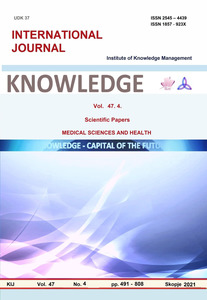Jovevska, Svetlana (2021) Anatomical variations of the Darwin's tubercles of the human ear in young population. Knowledge – International Journal, 47 (4). pp. 607-609.
![[thumbnail of Насловна.png]](/28468/1.hassmallThumbnailVersion/%D0%9D%D0%B0%D1%81%D0%BB%D0%BE%D0%B2%D0%BD%D0%B0.png)  Preview |
Image
Насловна.png Download (1MB) | Preview |
|
Text
ANATOMICAL VARIATIONS OF THE DARWIN'S TUBERCLES OF THE HUMAN.pdf Download (508kB) |
Abstract
Human external ear is a morphologically complex structure and plays a vital role in the
collection of sound. The present study would provide the information regarding the shape and size of the various
morphological structures of the ear in normal individuals which may help the plastic surgeons to reconstruct the
anatomy of the deformed ear and the physical and forensic anthropologists to study variations and establishing its
use as a biometrics. The aim of the study was the morphological examination of the ear and its features to
investigate the biological variations, sex differences, bilateral variations and further attempt to provide a database of
external ears
Methodology:The sample for the present study comprises of 60 males and 57 females aged of the 19 years.
Darwin’s tubercle is an important structure of the ear which is considered to have some evolutionary significance
was examinations.
Results: In this study shows the frequency distribution of the various shapes of the Darwin tubercles present on the
left and right ears of the subjects. Darwin’s tubercle refers to a congenital prominence usually found on the posterior
part of the helix of the ear In the present study, it shows a variety of structures in both the left and right sides in bot h
sexes.The trait is usually found on the posterior aspect of the helix; however, in some cases, it was also found on the
superior aspect in the present study .The study also shows that the nodosity type Darwin’s tubercle was more often
found on the males’ears than the females’ ears. Enlargement and projection form of the Darwin’s tubercle was
among the rest of the subject, and in few subjects, the Darwin tubercle was totally absent.
Conclusion: The present study shows that the individualistic characteristics of the ear can provide very useful
information for personal identification in forensic examinations. Darwin’s tubercle show a variety of structures and
individuality.
Keywords: Forensic science, Forensic anthropology, Personal identification, Human ear, Morphological variations
| Item Type: | Article |
|---|---|
| Subjects: | Medical and Health Sciences > Basic medicine |
| Divisions: | Faculty of Medical Science |
| Depositing User: | Svetlana Jovevska |
| Date Deposited: | 21 Sep 2021 09:06 |
| Last Modified: | 21 Sep 2021 09:06 |
| URI: | https://eprints.ugd.edu.mk/id/eprint/28468 |
Actions (login required)
 |
View Item |